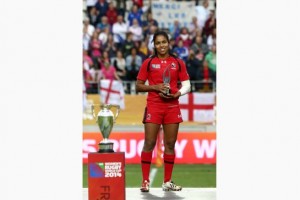Magali Harvey wins IRB Player of the Year
 When Magali Harvey — the new face of women’s rugby — first picked up a ball in high school, she could so easily have put it back down again and walked away.
When Magali Harvey — the new face of women’s rugby — first picked up a ball in high school, she could so easily have put it back down again and walked away.
“It was very scary because, at the time, there were no coaches who knew how to play rugby so they would just put you on the field and tell you to play,” Harvey said, recalling her introduction to the 15-a-side format in Quebec City.
“But, it definitely grew on me,” the 24-year-old added, in a phone call from Spain, where she’s holidaying after her World Cup whirlwind.
She may not have had the ideal start for a winger but last Sunday she showed the world that it hasn’t stopped her from becoming one of the best.
She helped her Canadian team to its first-ever silver medal at the Women’s Rugby World Cup in Paris and was named women’s rugby player of the year by the IRB.
“I knew we’d do amazing and we did,” Harvey said of Canada’s trip to the final. “I’m glad it paid off, all the hard work.”
The sport of rugby is one of the fastest growing in schools across Canada, driven, in part, by the inclusion of the fast-paced rugby sevens version of the game in the 2016 Olympics.
But funding, particularly for 15-a-side, hasn’t kept pace with the growth.
Just to get to the World Cup, each team member had to pull $10,000 out of their pockets, said coach Francois Ratier.
That’s why Harvey’s plan is to play in the 2016 Olympics, finish her business degree and then make money. There just isn’t any to be had in the women’s game and not much in the men’s game in Canada, either.
The Olympic dream “keeps me going,” she said. “That’s my ultimate goal and then I want to move on with my life.”
That Canadian captain Kelly Russell was also in the running for the player of the year award and six Canadians were picked for the world fantasy team shows how strong the nation is right now.
Keeping it that way won’t be easy, said Ratier.
“The challenge will always be the cost. How can we maintain the quality of players that will make the same sacrifices that this generation of players has made?” he said.
“I was fortunate to have 26 players who were able to make it and sacrifice their careers, their jobs, just to make that World Cup and train, but I don’t know how many times that will happen.”
In his 14 months as coach, the women had to attend five international events just to get to the World Cup and each trip cost around $2,000, Ratier said.
The prize for all that, if a player stayed healthy, was getting to compete in the World Cup against teams that are fully funded and, in the case of the French, even paid.
Harvey said she prefers not to think about the lack of money in women’s rugby.
“I do it for the love, I do it for the passion and do it because I love representing Canada.”
One of her next major opportunities to play for Canada will come in Toronto at the 2015 Pan Am Games.
That’s also an important opportunity for Rugby Canada to draw attention to the sport, which is obsessively followed in other parts of the world but not here at home.
“Every time we are in the spotlight and can show the quality of our athletes, 15s or sevens players, it’s a great opportunity to develop our sport,” Ratier said.
Harvey plays both versions of the game but her heart leans a little more to 15-a-side rugby, the game she started with.
“I also love sevens because there’s so much more space, there’s a lot of running involved and that’s clearly my strength,” she said.
That’s as close as this team player will get to drawing attention to her spectacular trythat got Canada through a tense semifinal match at the World Cup against the favoured host nation.
The Canadians looked to be in trouble in a scrum on their own try line until they freed the ball with some quick hands and passed it to Harvey. She ran 90 metres, dodging French players along the way, to score the try and subsequent convert.
IRB chairman Bernard Lapasset called it “perhaps the tournament highlight and certainly one of the tries of the year.”
It made sports highlight reels all over the country. But Harvey is quick to point out that some positions, like the one she plays, draw more attention than others but aren’t necessarily more important.
“A lot of people see my run as something spectacular . . . (but) the rest of the team worked just as well. Our back line was very agile and able to get me the ball,” she said.
“I trust my speed, I know my teammates trust my speed, that’s why I’m a winger, so I just booked it as fast as I could.”
At one point, she looked back and saw teammate Julianne Zussman urging her on.
“Go, just go,” she shouted.
By: Kerry Gillespie Toronto Star Sports Reporter, Published Wed. August 20 2014




